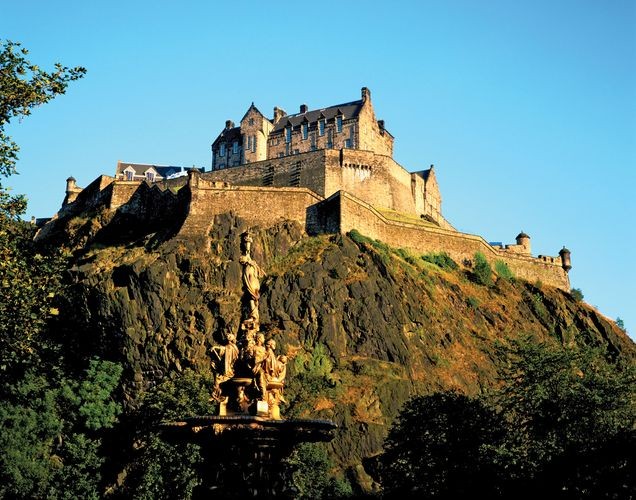Edinburgh Castle , stronghold that was once the residence of the Scottish monarchs and today serves mainly as a museum. It's 135 meters above sea level and overlooks the city Edinburgh from a volcanic rock called Castle Rock.

Castle Rock has been the scene of human activity for at least 3,000 years. 600 ce a Celtic Tribe called the Votadini or Gododdin, Eidyn Hill Fort had been built on the rock. The first King of Scotland known to have settled at Castle Rock was Malcolm III Canmore (reg. 1058-93). His pious wife, Queen Margaret, who 1093 in lock died and later canonized St. Margaret of Scotland , is thought in St. Margaret's Chapel, built approximately between 1130 and 1140 on the highest point of the rock and is the oldest surviving building was erected on the palace grounds.

Between 1296 and 1341 the castle was twice captured by English invaders and twice recaptured by the Scots. David's Tower, about 30 meters high, was built in honor of King David II Built who died in the castle in 1371 but was significantly destroyed in a siege 200 years later. A huge cannon named Mons Meg was installed in 1457 and can still be seen today. The Great Hall also preserved was 1511 from James IV. Completed . In a adjacent building called Royal Palace is the room where James VI, the future King James I by England , was born in 1566. After the devastating siege of 1571–73, the castle's defenses were strengthened with the construction of the Crescent Battery (cannon storage) and the Portcullis Gate. The last monarch to stay at Edinburgh Castle , was 1633 Charles I
Edinburgh Castle was repeatedly besieged in the 17th and early 18th centuries. It was snapped twice in order Covenanters while the Bishops' Wars from 1639 and 1640 and was taken by Oliver Cromwell 's New Model Army in 1650, while the English Civil Wars . Between 1689 and 1745, after the Restore (1660) of the monarchy, besieged Jacobite rebels unsuccessfully conquered the castle several times glorious revolution (1688), in the King James II was dropped , undo .
Between 1757 and 1814 the castle housed prisoners of war taken by the British in the Seven Years War , in the American Revolution and in the Napoleonic Wars . The New Barracks (1796–99) are still in use by the British military. Elsewhere in the castle grounds, Scotland pays tribute to its military heritage at the Scottish National War Memorial (opened 1927) and the National War Museum (opened 1933). Edinburgh Castle is now one of Scotland's most popular tourist attractions, attracting more than a million visitors a year. It is part of Edinburgh's Old Town and New Town, which since 1995 to UNESCO World Heritage Site .
Edinburgh Castle is the traditional depot of the Honors of Scotland, the Crown Jewels of the country . An older Relic Scottish kings is the Stone of Scone (or Stone of Destiny), which only arrived at the castle in 1996, exactly 700 years after it moved to England . The stone is a sandstone block, on which Scottish monarchs were traditionally crowned.
Just outside the castle drawbridge is a large open area called the Edinburgh Castle Esplanade, where grandstand seating is installed annually for an international military music festival called the Royal Edinburgh Military Tattoo and for other summer concerts. An event that takes place with greater frequency is the firing of a loud cannon on castle grounds at exactly 1:00 pm six days a week. The One O'Clock Gun, as it is known, was first fired in 1861 as a timekeeping service for ships anchored on the nearby Firth of Forth.


